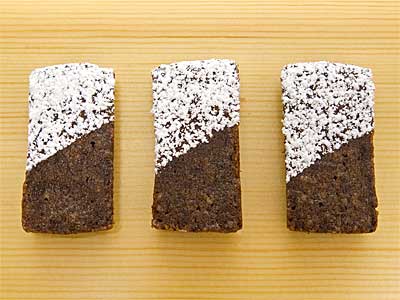June 18, 2012
Mignardise

financier aux noix de pécans et chocolat
(chocolate-pecan bars)
Once each winter, usually around Thanksgiving, my mother would make a kastanientorte, and each year, the whole family would look forward to it. A kastanientorte, at least my mother’s century-old version she learned from her mother, is a cake made from just chestnuts, eggs, sugar, and a touch of vanilla extract. If you want to use a different nut, say hazelnuts to make a haselnußtorte, substitute the ground hazelnuts for the ground chestnuts, adjust the ingredient ratios slightly, and you have your new cake.
In those days, we could only get chestnuts for a couple of months in the fall. Peeled, or otherwise prepare chestnuts, were not existent in our part of the world. Having to start with whole chestnuts meant that there would be a couple of days work to create the chestnut “flour“ for the cake.
Rather than roast the chestnuts, Mom’s method was to place the chestnuts in boiling water for 30 minutes. Then the pot was removed from the heat, but the chestnuts were left in the hot water. One chestnut was removed to cool a bit. After about a minute, another chestnut was removed, and the first one was peeled. This process was continued until all the nuts were peeled. It was necessary to completely remove both the outer shell (easy) and the inner skin (not so easy). The peeled nuts were arranged in a single layer on a cloth towel. This, in turn, was covered with another towel and left to sit out overnight.
The next morning, the now skinless, slightly soft nuts were made into a coarse flour. Initially, she used a strainer with a roller and scraper designed for making applesauce. In the 1966, she returned to Germany for the first time since she had left as a girl, 35 years earlier. While on the trip, she purchased a small nut grinder that became her tool of choice from then on.
The chestnut-peeling instructions sound simple enough, but by the time a half a kilo of chestnuts were shelled and peeled, my fingers were painfully burnt from handling the hot nuts—not hot enough to make a blister or scar, but hot enough to produce intense pain. In the end, the weight of the processed nuts was about two-thirds of the original weight. You can imagine how happy I was the first time I found pre-peeled chestnuts at a local store. The price of enough for one cake (400 g [scant 1 lb]) was barely more than the cost the raw nuts in their shells.
Because of the popularity of that chestnut cake, it was the first of my mother’s two, locally famous cakes that I attempted to make after leaving home. Since then I have made similar cakes with walnuts and hazelnuts as the “flour.”
One evening, I was at a friend’s house, and she made a nut cake that was similar in texture but had chocolate added to the ingredients. She said that the recipe was from Anne Willan’s LaVerenne Pratique, and that she had substituted pecans for the walnuts in the original recipe. I thought the cake was delightful, and added it to my repertoire.
Later the same year, my wife and I received our annual Christmas goodie box from a niece in Seattle. This year, the box contained five bags of sweets, each filled with a different kind of baked good. One bag was filled is miniature lemon cakes. They were sized like mini-cupcakes but without the paper wrappers. So naturally I thought of mignardise.
I prepared a quarter batch of the batter for the pecan-chocolate cake, stuffed it into a piping bag, and went looking through my various silicone molds to pick a shape to bake. I chose a cupcake shape and a financier shape. In the end, the financier shape won out because the cupcake shape wouldn’t release as easy from the rubber mold.
60 g (1⁄4 c)
room-temperature, unsalted butter
50 g (1⁄4 c)
granulated sugar, divided
1 large
egg, separated
60 g (2-1⁄8 oz)
ground pecans
55 g (1-15⁄16 oz)
ground, unsweetened chocolate
powdered sugar [optional]
1. Preheat oven to 150 °C (300 °F).
2. Place the butter and about three-fourths of the sugar in the bowl of a stand mixer fitted with a paddle attachment, and cream. Add and incorporate in order the egg yolk, nuts, and chocolate.
3. In a separate mixer bowl and with the mixer fitted with a whisk attachment, whisk the egg white until it starts to look fluffy. Add the remaining sugar, and beat until stiff peaks form.
4. Lighten the nut mixture with a little of the beaten egg white. Fold the nut mixture into the egg white.
5. Transfer the batter to a pastry bag fitted with a 1-cm (3⁄8-in) plain tip. Pipe the batter into the cavities on a silicone, mini-financier mold supported on a rimmed baking sheet.
6. Bake the financiers until done in the center, about 20 minutes. Transfer to a rack to cool.
7. Dust with powdered sugar in a decorative manner before serving [optional].
Yield: about 40 mini-financiers.
© 2012 Peter Hertzmann. All rights reserved.
